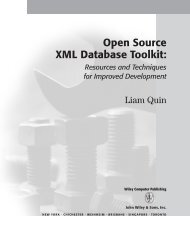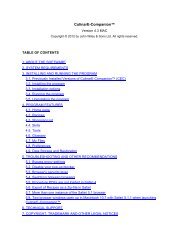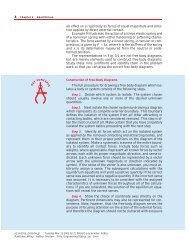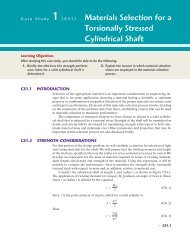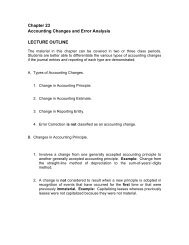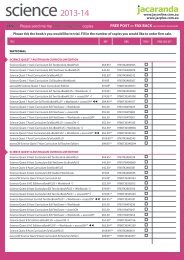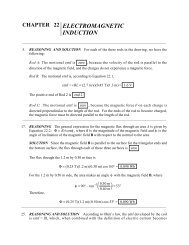Chapter Two - Wiley
Chapter Two - Wiley
Chapter Two - Wiley
You also want an ePaper? Increase the reach of your titles
YUMPU automatically turns print PDFs into web optimized ePapers that Google loves.
8956d_ch02_070 7/21/03 6:58 AM Page 70 mac76 mac76:385_reb:<br />
70 CHAPTER 2 A Further Look at Financial Statements<br />
inventory increased substantially. If inventory increased because the company is<br />
having difficulty selling its products, then the current ratio might not fully reflect<br />
the reduction in the company’s liquidity.<br />
Solvency<br />
Now suppose that instead of being a short-term creditor, you are interested in<br />
either buying Best Buy’s stock or extending the company a long-term loan. Longterm<br />
creditors and stockholders are interested in a company’s long-run<br />
solvency—its ability to pay interest as it comes due and to repay the balance of<br />
a debt due at its maturity. Solvency ratios measure the ability of the enterprise<br />
to survive over a long period of time. The debt to total assets ratio is one source<br />
of information about long-term debt-paying ability.<br />
Helpful Hint Some users evaluate<br />
solvency using a ratio<br />
of liabilities divided by stockholders’<br />
equity. The higher this<br />
“debt to equity” ratio, the lower<br />
is a company’s solvency.<br />
DEBT TO TOTAL ASSETS RATIO. The debt to total assets ratio measures<br />
the percentage of assets financed by creditors rather than stockholders. Debt<br />
financing is more risky than equity financing because debt must be repaid at<br />
specific points in time, whether the company is performing well or not. Thus,<br />
the higher the percentage of debt financing, the riskier the company.<br />
The debt to total assets ratio is computed by dividing total debt (both current<br />
and long-term liabilities) by total assets. The higher the percentage of total<br />
liabilities (debt) to total assets, the greater the risk that the company may be<br />
unable to pay its debts as they come due. The ratios of debt to total assets for<br />
Best Buy, for Circuit City, and industry averages are presented in Illustration<br />
2-18.<br />
Illustration 2-18 Debt to<br />
total assets ratio<br />
Debt to Total Assets Ratio <br />
Total Liabilities<br />
<br />
Total Assets<br />
2001 2000<br />
Best Buy<br />
($ in millions)<br />
$3,018<br />
$4,840<br />
$1,899<br />
62% 63%<br />
$2,995<br />
Circuit City 39% 46%<br />
Industry average 26%<br />
The 2001 ratio of 62% means that $0.62 of every dollar invested in assets by<br />
Best Buy has been provided by Best Buy’s creditors. Best Buy’s ratio exceeds the<br />
industry average of 26% and Circuit City’s ratio of 39%. The higher the ratio,<br />
the lower the equity “buffer” available to creditors if the company becomes<br />
insolvent. Thus, from the creditors’ point of view, a high ratio of debt to total<br />
assets is undesirable. Best Buy’s solvency appears lower than that of Circuit City<br />
and lower than the average company in the industry.<br />
The adequacy of this ratio is often judged in the light of the company’s earnings.<br />
Generally, companies with relatively stable earnings, such as public utilities,<br />
can support higher debt to total assets ratios than can cyclical companies<br />
with widely fluctuating earnings, such as many high-tech companies. In later<br />
chapters you will learn additional ways to evaluate solvency.



